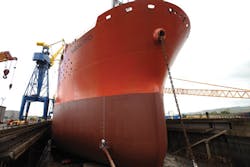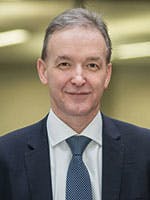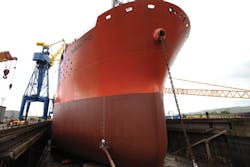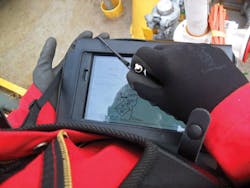Market downturn prompts redesigned, lower-cost projects
Diversified portfolio key to sustainability, says Wood Group CEO
Bruce Beaubouef
Managing Editor
Wood Group started out as a ship repair and marine engineering business in Scotland in 1912. After more than a century in business, the company has expanded its business activities to include oil and gas, industrial services, renewable energy, and power generation markets. Today, it operates in more than 40 countries, with approximately $5 billion in annual sales.
During that time, Wood Group has become an important player in the engineering, procurement, and construction market, particularly in the offshore oil and gas market. It has designed the world’s deepest spar production platform, the world’s largest semisubmersible topsides facility, some of the strongest platform moorings installed to date, and over 600,000 km of subsea pipeline.
Two years into one of the most severe downturns in industry history, Wood Group has been able to keep the contract awards coming in by re-engineering project designs, reducing project costs, and creating added value for its customers, says CEO Robin Watson.
Watson became CEO of Wood Group in January 2016, having previously served as COO and an executive member of the Wood Group board since 2013, initially as CEO of the Wood Group PSN division. With more than 30 years of engineering and industry experience, Watson has also actively engaged with various industry and governmental representative bodies, including as board member of Oil and Gas UK and the Oil and Gas Contractors Council.
Recently, Watson met withOffshore to discuss the opportunities and challenges of today’s offshore oil and gas market, some of its recent project awards, and Wood Group’s strategies for profitably executing these projects in a low oil price environment.
Offshore: How do you assess the current offshore oil and gas market, particularly the demand for EPCI services?
Watson: We’re all adjusting to the lower oil price environment. It’s certainly been a challenging two years across the industry. When you are a service company, the decline in activity levels is always the biggest challenge. One has to balance what the market is doing, how you manage your utilization levels, and how you position your company for any sort of recovery in the market, so retaining capability at a cost-effective level is key.
That said, we are seeing some of our end markets increase in activity levels, and our offshore engineering teams positioned themselves very well in 2014 and 2015; and we won a number of front-end engineering contracts, as well as engineering work on a range of upstream offshore projects. These include Leviathan, Peregrino 2, and most recently, Mad Dog 2. These contract awards, obtained amidst the market downturn, have been the result of positioning and pre-positioning by our offshore engineering team. We’re in good positions across the globe, including Saudi Arabia, and other locations in the Middle East and the Caspian region. Our U.S. shale business has also experienced a pick up in tendering and work levels. Not all markets have been equally affected by the downturn.
Offshore: What strategies has Wood Group employed to stay busy during the downturn?
Watson: Our main strategy, regardless of the state of the market, has been to add value for the customer. That said, we have reacted quickly to market conditions. We have reduced our cost base significantly over the last two years. We’ve implemented a new set of back office programs. At the end of this year, for example, 90% of our business will all be transacted to a common Oracle platform. That’s a significant investment we made even through the downturn. This investment has made it much easier for our customers to do business with us, and it’s made us more efficient in terms of how we execute our business. We’re a relatively straightforward business anyway, but we’ve used the downturn to make ourselves much more easy to understand, work with, and work for. I think those are some of the encouraging changes that we’ve made through the downturn.
Offshore: What types of EPCI services do you think will be most in demand, in the near and long term?
Watson: From a strategic perspective, we focus on having a good range of services. We are doing everything from projects, modifications, operations, maintenance, and engineering. We offer industrial and automation services; and we have subsea and asset integrity service lines. That range of services has been hugely helpful for us.
You might describe EPC as part of that, but I think that’s a subset of what we do rather than everything that we do. For example, when we execute an EPC project, there is generally some controls and instrumentation scope to the contract. So, quite often there is an opportunity for pull-through work for our automation business. If you’re constructing facilities in the field, then you need scaffolding, and you need to apply paint and other protective coatings. Those are opportunities for our industrial services unit.
We’re always looking to acquire, and offer, the right range of services. One of the reasons that we’re looking to acquire the Amec Foster Wheeler business is that they would give us a broader range of end markets. Two and a half years ago, Wood Group was 95% upstream oil and gas. With the downturn in oil and gas, and with us taking positions in new markets, we’re now 85% oil and gas. With the potential acquisition of Amec Foster Wheeler, we’ll have a 55% to 75% oil and gas footprint. We think that’s important, because if you’ve got a broad range of services and a broad range of end markets, you become a bit less cyclical in terms of your service supply and demand. Strategically, that’s where we’ve been positioning the group for the past three years.
Offshore: Operators are obviously becoming more conscious of costs in a $50/bbl price environment. Can you talk about the kinds of production facility and field development designs that Wood Group is offering to help operators remain profitable?
Watson: I think if you look at the projects we’ve won, it’s been a good testament to our ability to design projects that are cost effective in this price environment. Mad Dog 2 is a great example, but there are others. Leviathan is another example. In the conceptual stage, it started out as a floating facility. We’ve been able to redesign it as a fixed jacket platform, which has made it a cost-effective project for Noble Energy.
Traditionally, Wood Group has been able to offer this type of service, making projects more cost effective. For example, over the years we have been able to offer increasingly light-weight topsides designs. In this process, we start by examining ways to reduce the weight of the equipment, and also reducing the amount of space that that equipment needs on the topsides. What you inevitably do is you reduce complexity, you reduce your lifting requirements, and you reduce costs. You can lift smaller components that weigh less, and it’s easier to assemble offshore facilities. And if it’s simpler, lighter, and easy to do, it’s generally quicker. You actually bring the project, first oil or first gas, forward.
That’s the big value for customers. If they can get a commercial proposition that monetizes the project, and then you can execute it, essentially you simplify things and do it quickly, that brings you your cash flow earlier. That is really attractive in this environment, but we were doing this type of work before the downturn. Our work on the Lucius and Heidelberg projects could be cited, where we designed one facility, then two were built to that standard. Anadarko is an innovative operating company; and as the engineering contractor, we were really happy to make one design, and then modify it to minimum level. That successful design of the first project enabled us to accelerate the second project. We had more certainty when it came to commissioning. You knew the equipment well. You knew what equipment worked. You knew what learnings you had. This type of standardized approach is really valuable to customers, so they’re standardizing design.
Offshore: You mentioned the change in the platform design on the Leviathan project. What kind of production facility design trends do you see, moving forward?
Watson: I think it’s difficult to pick a trend and say, “this is what’s happening globally.” If we look at the portfolios that a typical customer has in 2017, that customer may well have an onshore play being drilled, offshore fields being developed, both deepwater and shallow water; they will have conventional and unconventional resources to develop; and some of them will have both upstream and downstream businesses. My point is that, these days, customers often have a much more complex portfolio in terms of the assets and the reserves that they have.
Being able to service all those different components is a key part of the Wood Group story. In the seven years that I have been with Wood Group, we have worked very hard to make sure that we, as a service provider, match our customers’ end market portfolio. For example, if one wants to have a relationship with ExxonMobil - a very valued customer of ours - across the globe, one needs to be able to partner with XTO in the shale market. And their portfolios can change. If you look at Shell with the BG acquisition, they now have a very large gas portfolio, and a significant LNG portfolio. That’s been a transformational acquisition from a Shell perspective. Their portfolio now has shifted significantly in terms of its gas to oil balance.
What we’ve done is we’ve tried to position our businesses and our services such that we have a good range of customers, the right geographic locations, and the right service offerings in each of the basins in which they operate. If the client’s field is in ultra-deep water, a floating facility becomes a much more sensible design criteria for the installation due to the environmental conditions. So the concept design of the production facility will always depend on a number of variables.
On top of that, you need to know which yards are busy, which fabrication facilities are busy, and which ones are quiet - if you know that, then deals can be made that will help move things forward, and help the client get their facility built and installed. For us, those kinds of things will have a major factor in the decision-making process. There is another important factor, which will realize and take into account - all projects are global projects. If you do a project in the Gulf of Mexico, there will be rotating machinery that comes in from all around the world, there will be valves from around the world, there will be pipework coming in from around the world. So it’s very difficult to actually look at any one project now and think it’s been designed in one way in one region, and everything in that region is designed in the same way - because it’s such a global marketplace. I think the good thing for Wood Group is making sure that we can provide that range of services across the portfolios that our customers have.
Offshore: Automation and standardization are hot topics within the industry right now. But of course, there are a lot of challenges and resistance to change. What do you think are the biggest challenges to digitization within the industry?
Watson:With regard to automation, digitization, and the man-machine interface, you can either view these things as potential disruptors to your business, or you can view them as opportunities. No one can stem the tide of technology, particularly the use of technology in a process-oriented environment. We have a variety of projects which are focusing on this very issue. We created a seed fund, and the innovative ideas come from the business itself. It has involved some internal work, and some third-party work; and we’ve taken a number of these ideas through pilot projects with customers. In a number of cases, we’ve actually monetized these efforts by developing a commercial model that really innovates the business. The range is quite broad, so at one end, we’re focusing on using digital data and state-of-the-art design applications to shift and change the design process so that they can be simpler and quicker, and less complex in terms of the number of interfaces.
At the other end of it, we’re making greater use of electronic work and documentation systems with laptops and field tablets. We have been using those systems in the offshore UK market for years. But now with improved bandwidth, we can get streaming information from offshore to onshore quite easily. So these days, we can get feedback on machinery placed on an offshore facility from our experts across the globe, wherever they may be. They don’t have to make a trip to the offshore facility itself. This type of technology can bring tremendous efficiencies. We’ve really made a significant effort to innovate in this arena, and embrace the technologies that provide us with an opportunity to differentiate ourselves in the marketplace.
Offshore:Wood Group has been quite active with acquisitions in the past few years: Enterprise Engineering (June 2016); Agility Group/Agility Projects (July 2014); and Pyeroy Group (July 2013) - and now of course, the proposed acquisition of Amec Foster Wheeler. Can you speak to the larger strategy here?
Watson: Acquisitive growth has always been part of our model. We have a good bit of organic growth, where we generally build on the foundation of existing customer relationships. But in addition to that, we are always on the lookout to obtain a new service or technical capability through acquisition. For example, in the case of Pyeroy Group, we had an opportunity to obtain some industrial services that we did not have in-house at the time. And since then, we have grown that business significantly. We took a non-oil and gas industrial services business and started to sell industrial services in oil and gas.
We have a lot of examples like that. We’ve acquired over 50 companies since we went public in 2002, so growth through acquisition has been a key part of our strategy. The largest transactions that we have made to date was the acquisition of PSN in 2011. That gave us one of the largest brownfield service providers in the industry. Now, with the proposed Amec Foster Wheeler transaction, which potentially will be the single-largest acquisition that Wood Group has ever done. That deal should be complete later this year, subject to shareholder and regulatory approvals.
Offshore: Wood Group is also taking part in a subsea equipment reliability study that is focused on the offshore Australia market. Can you talk about the overall goals and objectives of this study?
Watson: That’s typical of the stuff we do. We always stay engaged in the markets and communities we are involved in, and we have a good reputation for technical excellence in the subsea arena. So in this case, we were looking at the fully installed cost of some of the developments in Australia, and we found that they were relatively expensive from a subsea perspective. So we took some of the experiences and observations we have had from our global footprint, and used them to work closely with a number of participants in the offshore Australia market. We felt there was an opportunity for some important industry learnings here. We got involved with all sorts of stakeholders including our customers, technical companies, installation providers, and equipment providers. Working together, we have helped create what we think is an encouraging forum to try and look at the pricing, efficiency, and reliability of various types of subsea equipment. Of course, the problem can be that if the prices for various products and services becomes set too high, that becomes a base for that region. And if operators, developers, and investors think that the return on investment is not sufficient, then they will not invest in those parts of the world. So besides subsea equipment reliability, which is obviously important, this was an effort to help preserve the viability of the subsea oil and gas market offshore Australia. And we believe that we have helped achieve some learnings there that will keep that market viable.
Offshore: How do you see the opportunities long term with regard to brownfield versus greenfield projects?
Watson: I think it maybe comes back to the earlier discussion. There is quite a mix. We’ve always tried to balance these markets, so from a Wood Group perspective, we try to be an asset-light business. We don’t have big factories that make equipment; we don’t have vessels. We’re a people-oriented business. We try and mix our capex and opex-oriented work, so we are broadly around 50-50%, maybe 60-40% operating-related expenditure versus capital-related expenditure. We have a good, broad customer mix throughout several regions and basins.
Generally, with greenfield projects, you have the potential to capture higher margins for the services you provide, subject to performance, but these types of projects rely upon capital expenditure, and it can be somewhat cyclic. With brownfield projects, you generally have slightly lower margins, but you do have enduring periods of demand for those services. We’ve always tried to balance the portfolio, and that seems to work well for our customers. For many of our customers we do both greenfield and brownfield work.
With our larger customers, we tend to have relationships with both their development and production divisions. Often, they will place their brownfield work under their production division, and their greenfield work will be under their development division. So at Wood Group, we try to have relationships across both areas; and actually, increasingly in the downstream side as well.
Offshore: Many within the industry see ~$50/bbl oil as the new normal. With lower-cost onshore activities ramping up in the US, how will the offshore industry be able to compete in the near term and long term? What will need to happen for the offshore oil and gas industry to stay viable?
Watson: I think, again, you come back to the portfolio. Different fields will have different economics. That will be based on the recoverability of the reserves and the capital you need to execute the project. I don’t think it’s either onshore or offshore, and I don’t think it’s either conventionals or unconventionals. I think one needs a healthy breadth to the service portfolio. In fact, if we even look at unconventionals, some shale basins are attractive at $50/bbl, and some are not. There is a range on the economic continuum, a break-even point even in the unconventional plays.
I do think this is probably the worst downturn in probably three or four decades. There are some encouraging signs in some basins and some subsectors, but across oil and gas globally, I think there are still a lot of challenges. We have certainly been clear in saying that we still have a lot of challenges in our business. I think you’ll see a different rate of recovery across the different basins really derived by the economics of individual projects, or the lifting costs of certain fields, and that will dictate some of the decision making.
Despite these challenges, we believe that we are well positioned to provide services across a good range of end markets; and our shareholders, in turn, give us the capability and certainty that we need to grow and create jobs and local employment, and all the things that go with having a good, quality business. That’s our focus. Managing that portfolio of end markets as well as a range of services, we think, is the right strategy.




